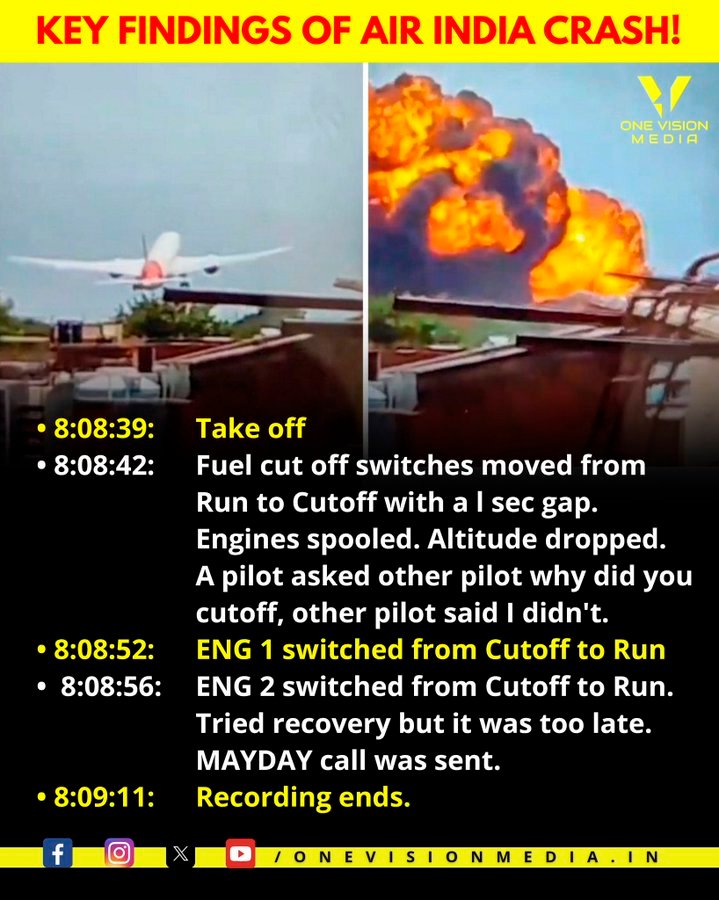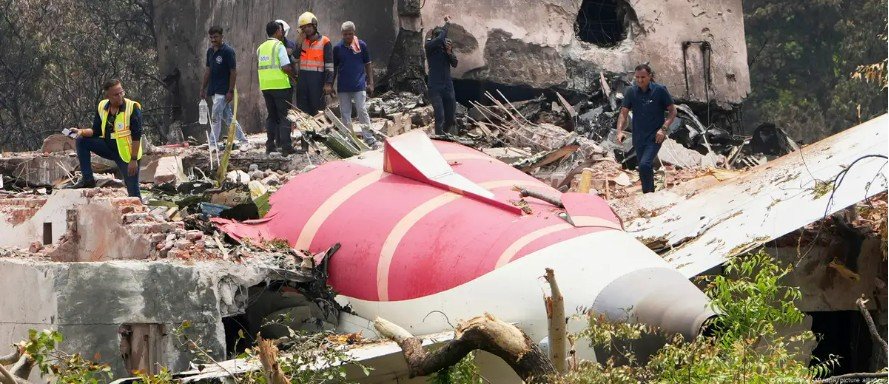Overview
On June 12, 2025, Air India Flight AI 171 tragically crashed near Ahmedabad just minutes after takeoff, sending shockwaves across the country. The incident, which involved over 97 passengers and crew members, raised urgent questions about aviation safety, aircraft systems, and pilot response. While initial reports pointed to a possible fuel switch error, the recently released official crash report by the Aircraft Accident Investigation Bureau (AAIB) sheds more light—yet leaves some questions unanswered.

Meanwhile, families of the victims are still demanding justice and accountability while aviation experts look into the events leading up to the crash. Let’s examine the report’s main conclusions and the implications of this tragedy for Indian aviation’s future.
A Brief Summary of the AI 171 Crash
Air India Flight AI 171, traveling from Mumbai to London, crashed shortly after takeoff near Ahmedabad on June 12, 2025, resulting in the deaths or critical injuries of all 97 people on board. Initial speculation centered on possible human error or fuel system failure. The Aircraft Accident Investigation Bureau (AAIB) confirmed that the crew had left the fuel switches in the “RUN” mode, but a sudden systems malfunction or miscommunication may have played a critical role in the crash.
Timeline of Events
Here’s a quick overview of what reportedly happened during the ill-fated flight:
-
8:45 AM—Air India Flight AI 171 took off from Sardar Vallabhbhai Patel International Airport, Ahmedabad, en route to London.
-
8:58 AM—The aircraft began losing altitude rapidly. Air traffic control lost all communication with the cockpit.
-
9:00 AM—As a result, the plane crashed into a residential building near Ahmedabad, causing a massive explosion and widespread damage.
-
9:30 AM—Emergency response teams arrived at the site and initiated rescue operations.
-
10:00 AM—Investigators reached the location and started site analysis. Victims were transported to nearby hospitals.
-
June 13, 2025— The Aircraft Accident Investigation Bureau (AAIB) officially launched its investigation into the crash.
This sequence of events later became a critical part of the Air India crash report.

What Investigators Found in the Air India Crash Report
Several important details are revealed in the AAIB’s official crash report:
-
Fuel switches Confirmed in ‘RUN’ mode.
Contrary to earlier speculation, the fuel switches were not turned off. Investigators confirmed they were set to “RUN,” which rules out deliberate fuel cutoff. However, However, the report suggests a possible malfunction or misinterpretation by the crew, leading to an unintentional shutdown or system failure.
-
A breakdown in crew communication
The report highlights that no Mayday call or distress signal was received from the cockpit. This indicates either a sudden systems failure or a lack of time for the pilots to react, which hindered coordination with ground control.
-
Loss of Altitude and Sudden Engine Shutdown
Furthermore, black box data showed a rapid loss of altitude just 13 minutes after takeoff. A sudden failure caused one of the engines to shut down unexpectedly, potentially due to a fuel delivery problem or electrical malfunction affecting engine control systems.

What Was Found in the Wreckage
The crash site revealed a scene of utter devastation. Wreckage from Air India Flight AI 171 was scattered across a wide area near a densely populated neighborhood in Ahmedabad.
- Severely Burned Aircraft Parts
Much of the aircraft—including the fuselage, engine compartments, and interior cabin components—was charred beyond recognition. Consequently, Consequently, some parts had melted due to extreme heat, making identification nearly impossible.
- Tail Section Embedded in Building
One of the most striking images from the site was the tail section of the aircraft lodged in the upper wall of a hostel building, showing the force and angle of impact. Emergency officials—and even Prime Minister Narendra Modi—later inspected this section, who visited the crash site.
Families Seek Accountability
In the aftermath of the crash, families of the victims are still demanding justice, transparency, and proper compensation. Several families have voiced concerns that authorities failed to keep them adequately informed during the investigation process.
“We deserve to know what happened to our loved ones,” said one grieving father in a televised interview.
“We haven’t even received proper answers, let alone closure.”
There is rising pressure on both Air India and the Directorate General of Civil Aviation (DGCA) to provide timely updates, address emotional needs, and ensure policy changes are made.
Moreover, many families are also pushing for reforms in aviation safety, including stricter maintenance checks, mental health evaluations for crew, and real-time updates during aviation emergencies.
Survivors’ Ongoing Trauma
Of the 97 people on board, only a few miraculously survived—but they continue to live with deep physical and emotional scars.
According to reports, one survivor now avoids speaking about the incident entirely, and struggles with recurring nightmares and anxiety. While some have received psychological support and trauma counseling, the road to recovery remains long and uncertain.
Mental health experts now urge authorities to implement long-term support systems, not just for survivors but also for families of the deceased.
“This isn’t something you recover from in a few weeks,” noted Dr. Kavita Sinha, a trauma psychologist.
“As a result, the emotional toll of an aviation disaster can last for years, if not decades.”
Expert Insights from the Air India Crash Report
Insights from the Air India plane crash report have triggered a wider discussion among aviation experts. Former pilots and aviation experts have offered their opinions on the AI 171 crash, highlighting a number of possible causes and takeaways:
These expert insights complement the technical findings outlined in the Air India plane crash report and provide valuable context to the incident.
- Experts believe human error in managing the fuel system may have triggered the failure.
- Inadequate checklist procedures and crew training may have played a role.
- The reliance on automated systems must be balanced with manual oversight.
“Fuel system errors are rare but can be fatal when they happen mid-air,” said Captain Ravi Mehta, a former Air India pilot. “This crash shows we need better simulation training and faster manual override capabilities.”
Future Aviation Reforms After the Air India Plane Crash Report
Aviation authorities are likely to introduce major safety reforms after this crash. Reports suggest that the Directorate General of Civil Aviation (DGCA) has started reviewing several procedures, including
- Mandatory simulations for emergency fuel system failures
- More frequent inspections of aircraft systems
- Stricter certification for older aircraft models
- Better mental health support and crew fatigue management
Based on the Air India plane crash report, the Directorate General of Civil Aviation (DGCA) is reviewing multiple safety procedures. Air India, now owned by the Tata Group, has issued a statement affirming full cooperation with authorities and confirmed that they’ve launched an internal safety audit.
Public Reactions to the Air India Plane Crash Report
Understandably, the tragedy sparked massive public outcry. Social media platforms like X (formerly Twitter) were flooded with hashtags such as #AirIndiaCrash, #AI171Report, and #JusticeForAI171Victims.
For instance, live news coverage showed heartbreaking visuals of the wreckage and emotional interviews with grieving families. Moreover, across multiple cities, Citizens across multiple cities organized candlelight vigils to pay tribute to the victims.
Air India Crash Report: Public Reaction and Government Response
Following the release of the report, the Ministry of Civil Aviation vowed to take immediate corrective steps. A government representative, during a public address, remarked:
“We are taking the findings seriously and will implement recommended changes without delay.”
In response, several aviation officials have already started discussing revisions to national safety protocols.
What the Air India Crash Report Teaches Us: A Call for Safer Skies
The Air India plane crash report does more than outline the technical causes behind the AI 171 tragedy—it serves as a sobering reminder that lives depend on the smallest switches, overlooked protocols, and human decisions.
As grieving families seek justice and aviation professionals rethink their systems, one thing becomes clear: India’s aviation industry must evolve quickly and transparently.
Every investigation is not just a post-mortem—it’s a chance to prevent the next disaster. Ultimately, by learning from the pain and lessons of AI 171, we can hope for a future where such tragedies remain a distant memory, never to be repeated.

FAQs
Q1. What led to the crash of the Air India AI 171?
A: According to the Air India plane crash report, a possible mechanical or manual error involving the aircraft’s fuel switch system may have caused the incident.
Q2. Did anyone survive the collision?
A: Yes, a few passengers survived, but most are still recovering from serious physical and emotional trauma.
Q3. Has Air India responded to the crash report?
A: Yes, Air India has cooperated fully with the authorities and has initiated an internal safety audit.
Q4. How does the AAIB fit into this report?
A: The Aircraft Accident Investigation Bureau (AAIB) conducted the investigation and released the official crash report.
Q5. What changes are expected in airline safety after this report?
A: New rules are expected, including stricter aircraft checks, enhanced training, and better crew mental health protocols.
Q6. What is the status of the survivors now?
A: Currently, survivors are undergoing treatment and counseling to recover from the psychological and physical impact of the crash.













Kalden Doma
An internationally renowned thought leader in rediscovering & mind training life skills. Kalden Doma has been delivering inspirational lectures across the globe for over 17 years. A driven entrepreneur, started a mind training academy in 2001. She coaches students, entrepreneurs, & executives.